Valid forms of syllogistic arguments
AAA-1 Modus Barbara

Example::
Premises:
Some A is B
Some C is A
Conclusion:
All C is A
Similar to case 2. The middle terms are switched with the predicate and subject.
Rule 1: When statements are positive, then the conclusion must be positive.
Rule 3: The middle term, B, is distributed in the major premise.
Rule 5: C is distributed in both the conclusion and the minor premise.
AAI-1 Modus Barbari
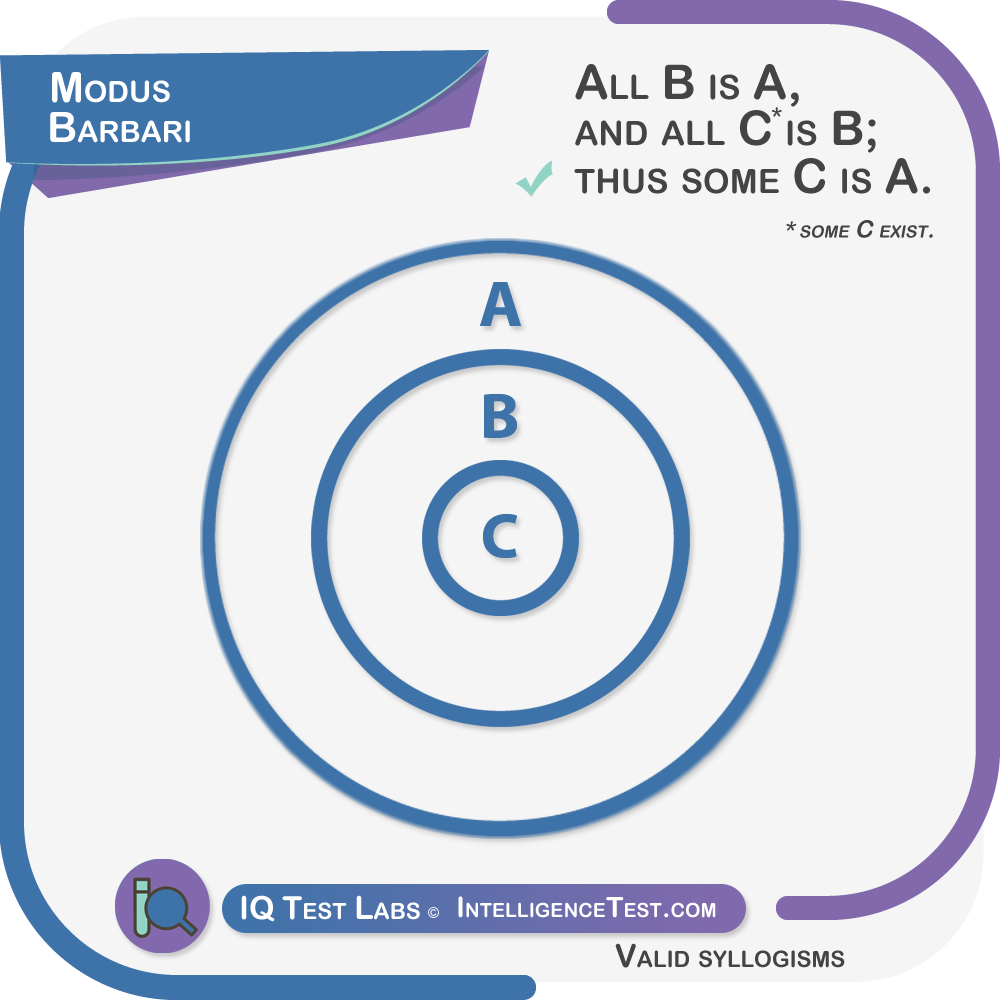
Example::
Premises:
All B is A
All C is B
Conclusion:
Some C is A
Similar to case 2. The middle terms are switched with the predicate and subject.
Rule 1: When statements are positive, then the conclusion must be positive.
Rule 3: The middle term, B, is distributed in the major premise.
EAE-1 Modus Celarent
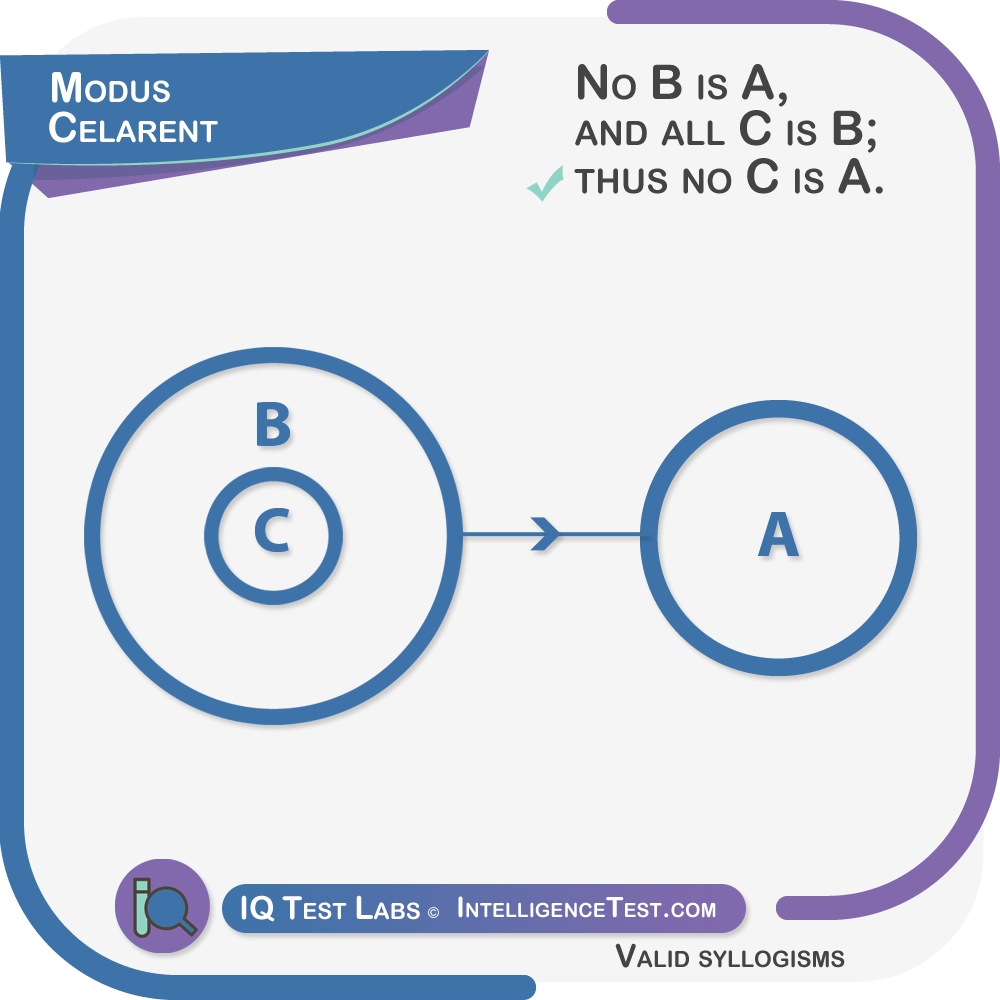
Example::
Premises:
No B is A
All C is B
Conclusion:
No C is A
Similar to case 10.
Rule 3: The middle term, B, is distributed in the major premise.
Rule 4: A is distributed in the conclusion and the major premise.
Rule 5: C is distributed in the conclusion and the minor premise.
Rule 7: If one statement is negative, the conclusion must be negative.
EAO-1 Modus Celaront
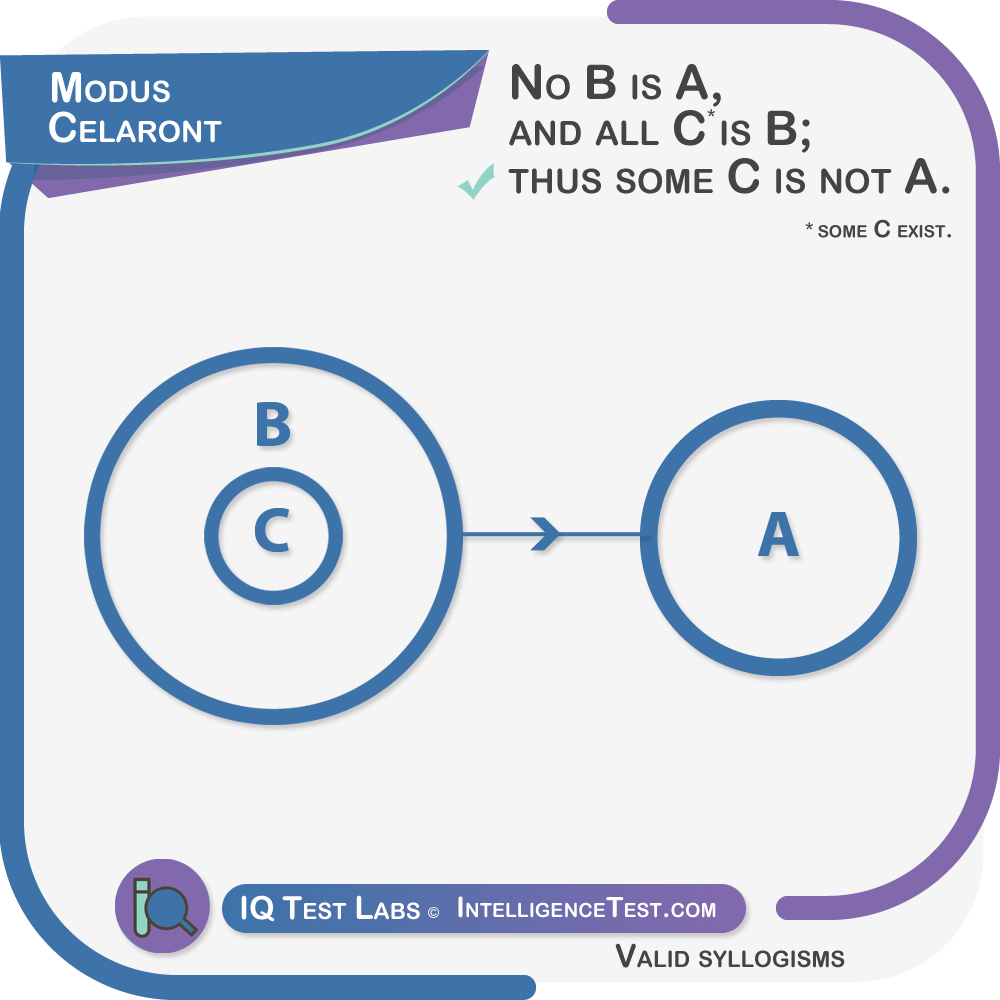
Example::
Premises:
No B is A
All C is B
Conclusion:
Some C is not A
Similar to case 10.
Rule 3: The middle term, B, is distributed in the major premise.
Rule 4: A is distributed in the conclusion and the major premise.
Rule 5: C is distributed in the conclusion and the minor premise.
Rule 7: If one statement is negative, the conclusion must be negative.
AII-1 Modus Darii
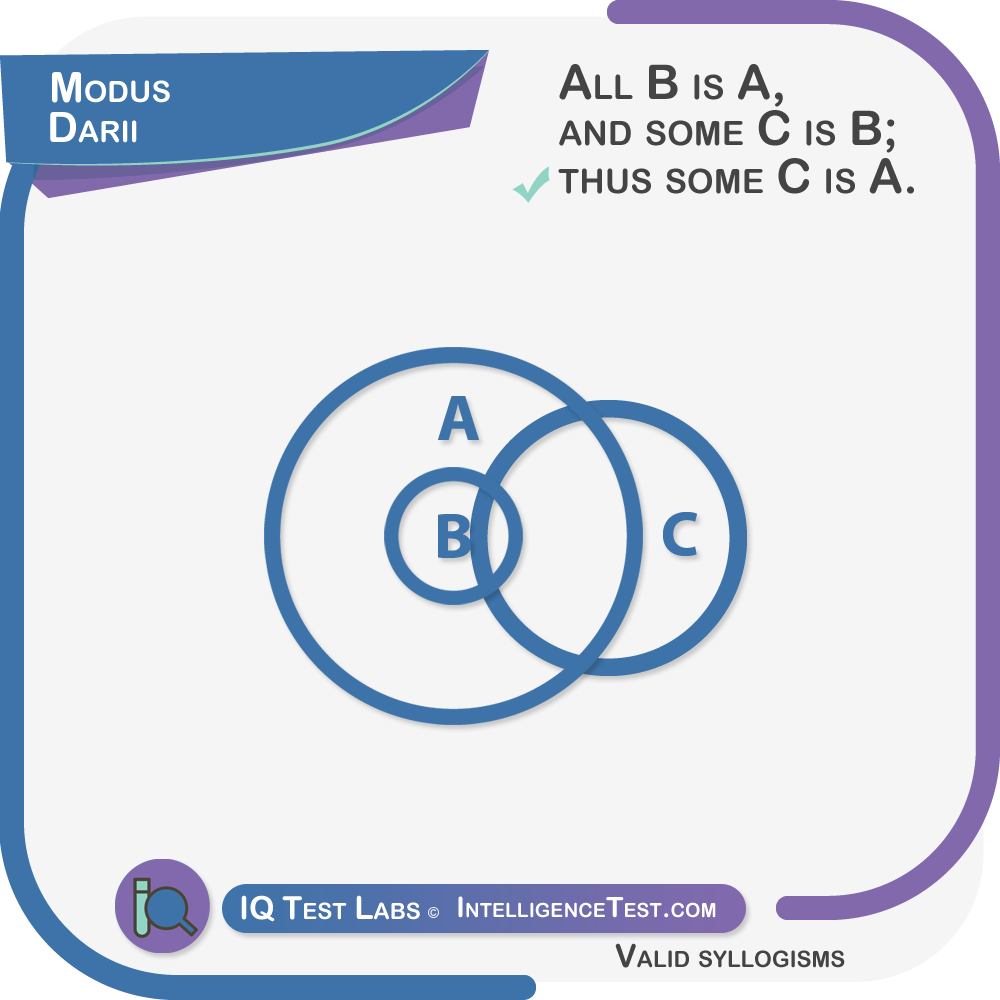
Example::
Premises:
All B is A
Some C is B
Conclusion:
Some C is A
Rule 1: When the premises are positive, then the conclusion must be positive.
Rule 3: The middle term, B, is distributed in the major premise.
EIO-1 Modus Ferio
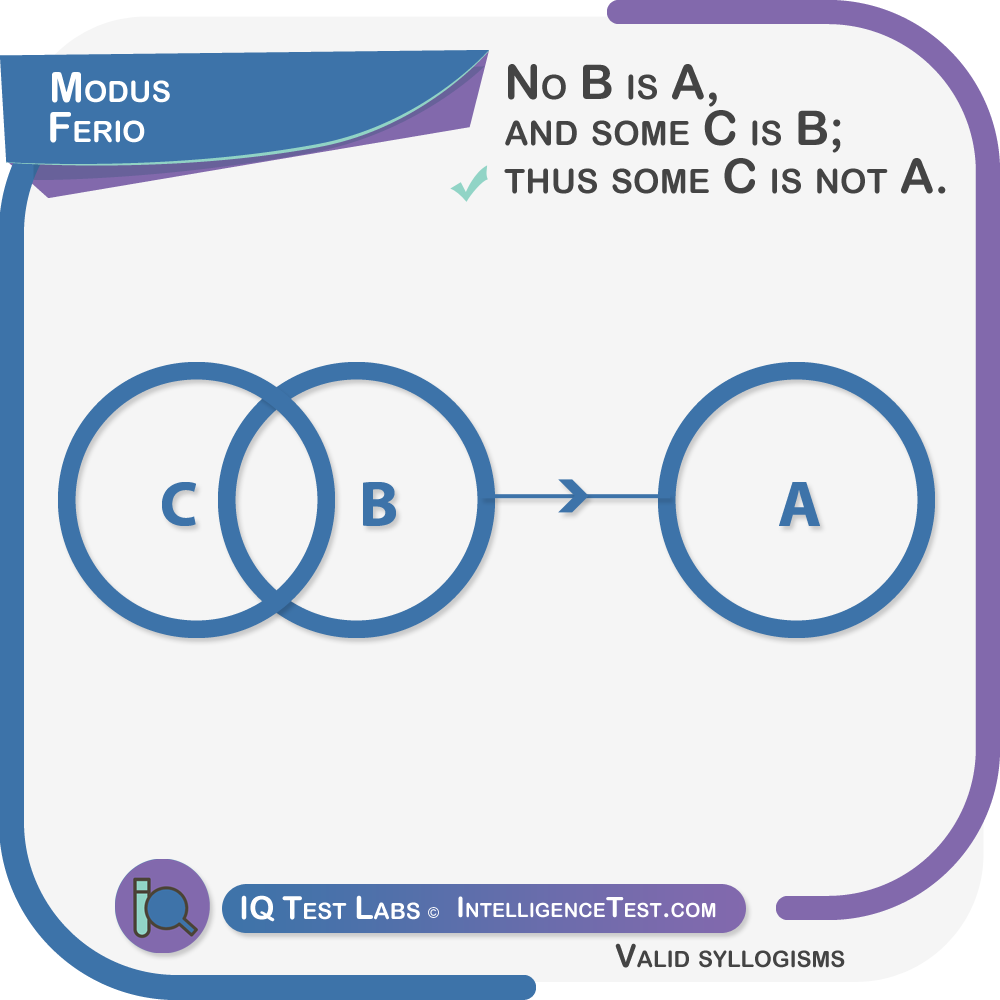
Example::
Premises:
No B is A
Some C is B
Conclusion:
Some C is not A
Rule 2: When 'No' appears in a statement, 'Some-not' should follow as a valid possible conclusion.
Rule 3: The middle term, B, is distributed in the major premise.
Rule 4: A is distributed in the conclusion and the major premise.
Rule 7: If one statement is negative, the conclusion must be negative.
AEE-2 Modus Camestres

Example::
Premises:
All A is B
No C is B
Conclusion:
No C is A
Rule 3: The middle term, B, is distributed in the major premise.
Rule 4: A is distributed in the conclusion and the major premise.
Rule 5: C is distributed in the conclusion and the minor premise.
Rule 7: If one statement is negative, the conclusion must be negative.
AEO-2 Modus Camestros
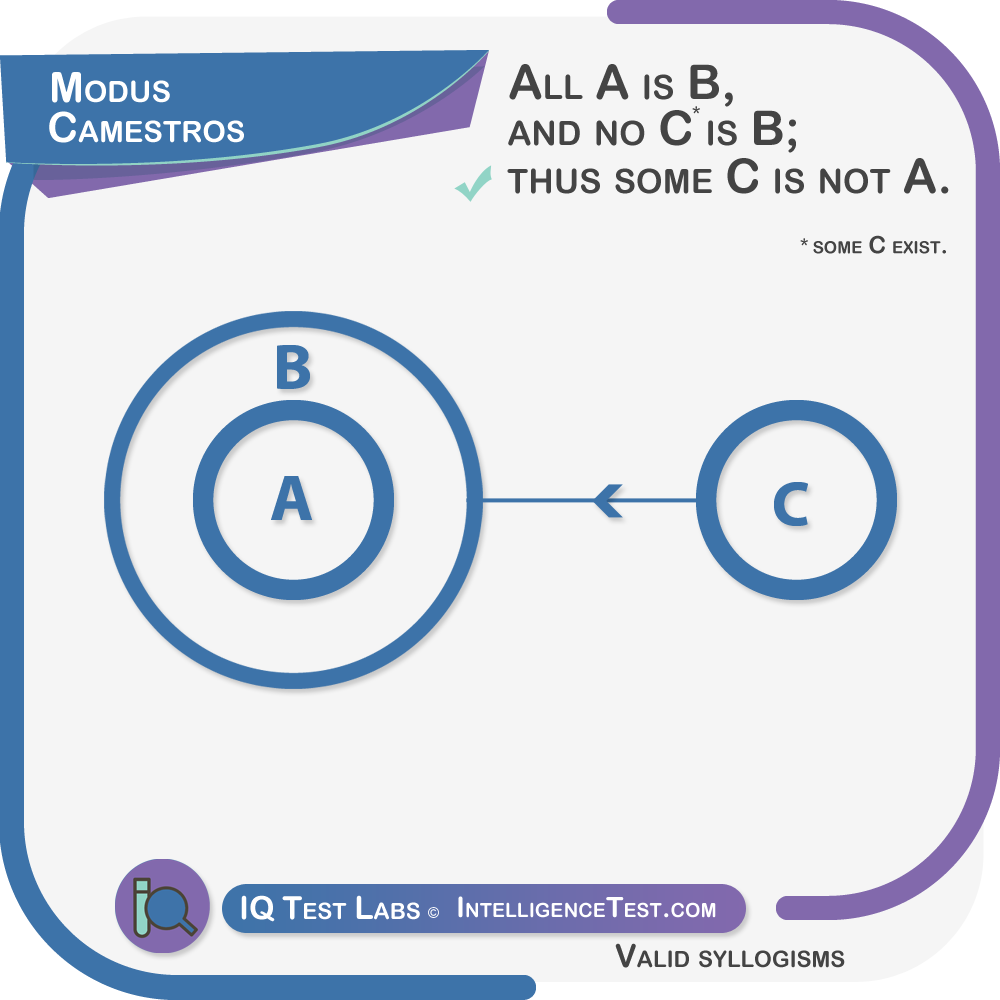
Example::
Premises:
All A is B
No C is B
Conclusion:
Some C is not A
Rule 3: The middle term, B, is distributed in the major premise.
Rule 4: A is distributed in the conclusion and the major premise.
Rule 7: If one statement is negative, the conclusion must be negative.
Baroco
AEE-2 Modus Camestres

Example::
Premises:
All A is B
No C is B
Conclusion:
No C is A
Rule 3: The middle term, B, is distributed in the major premise.
Rule 4: A is distributed in the conclusion and the major premise.
Rule 5: C is distributed in the conclusion and the minor premise.
Rule 7: If one statement is negative, the conclusion must be negative.
OAO-4 Modus Bocardo
Example::
Premises:
Some B are not A
All B are C
Conclusion:
Some C are not A
Rule 3: The middle term, B, is distributed in the major premise.
Rule 4: A is distributed in the conclusion and the major premise.
Rule 7: If one statement is negative, the conclusion must be negative.
AAI-4 Modus Bamalip
Example::
Premises:
All A is B
All B is C
Conclusion:
Some C is A
Rule 1: When both premises are positive, then the conclusion must be positive.
Rule 3: The middle term, B, is distributed in the major premise.
Rule 4: A is distributed in the conclusion and the major premise.
EAO-3 Modus Felapton
Example::
Premises:
No B is A
All B is C
Conclusion:
Some C is not A
Rule 3: The middle term, B, is distributed in the major premise.
Rule 4: A is distributed in the conclusion and the major premise.
Rule 7: If one statement is negative, the conclusion must be negative.
AAI-3 Modus Darapti
Example::
Premises:
All B is A
All B is C
Conclusion:
Some C is A
Rule 1: When the premises are positive, then the conclusion must be positive.
Rule 3: The middle term, B, is distributed in the major premise.
EAE-2 Modus Cesare
Example::
Premises:
No A is B
All C is B
Conclusion:
No C is A
Rule 3: The middle term, B, is distributed in the major premise.
Rule 4: A is distributed in the conclusion and the major premise.
Rule 5: C is distributed in the conclusion and the minor premise.
Rule 7: If one statement is negative, the conclusion must be negative.
EAO-2 Modus Cesaro
Example::
Premises:
No A is B
All C is B
Conclusion:
Some C is not A
Rule 3: The middle term, B, is distributed in the major premise.
Rule 4: A is distributed in the conclusion and the major premise.
Rule 7: If one statement is negative, the conclusion must be negative.
EIO-2 Modus Festino
Example::
Premises:
No A is B
Some C is B
Conclusion:
Some C is not A
Rule 3: The middle term, B, is distributed in the major premise.
Rule 4: A is distributed in the conclusion and the major premise.
Rule 7: If one statement is negative, the conclusion must be negative.
AII-3 Modus Datisi
Example::
Premises:
All B is A
Some B is C
Conclusion:
Some C is A
Rule 1: When the premises are positive, then the conclusion must be positive.
Rule 3: The middle term, B, is distributed in the major premise.
Rule 10: If a statement begins with 'some', the conclusion must begin with 'some'.
EIO-3 Modus Ferison
Example::
Premises:
Some B is C
No C is B
Conclusion:
Some C is not A
Rule 3: The middle term, B, is distributed in the major premise.
Rule 4: A is distributed in the conclusion and the major premise.
Rule 7: If one statement is negative, the conclusion must be negative.
AEE-4 Modus Calemes
Example::
Premises:
All A is B
No B is C
Conclusion:
No C is A
Rule 3: The middle term, B, is distributed in the major premise.
Rule 4: A is distributed in the conclusion and the major premise.
Rule 5: C is distributed in the conclusion and the minor premise.
Rule 7: If one statement is negative, the conclusion must be negative.
AEO-4 Modus Calemos

Example::
Premises:
All A is B
No B is C
Conclusion:
Some C is not A
Rule 3: The middle term, B, is distributed in the major premise.
Rule 4: A is distributed in the conclusion and the major premise.
Rule 7: If one statement is negative, the conclusion must be negative.
AEO-4 Modus Fesapo
Example::
Premises:
No A is B
All B is C
Conclusion:
Some C is not A
Rule 3: The middle term, B, is distributed in the major premise.
Rule 4: A is distributed in the conclusion and the major premise.
Rule 7: If one statement is negative, the conclusion must be negative.
IAI-4 Modus Dimatis
Example::
Premises:
Some A is B
All B is C
Conclusion:
Some C is A
Rule 3: The middle term, B, is distributed in the major premise.
Rule 9: If a statement begins with 'some', the conclusion must begin with 'some'.
EIO-4 Modus Fresison
Example::
Premises:
No A is B
Some B is C
Conclusion:
Some C is not A
Rule 3: The middle term, B, is distributed in the major premise.
Rule 4: A is distributed in the conclusion and the major premise.
Rule 7: If one statement is negative, the conclusion must be negative.